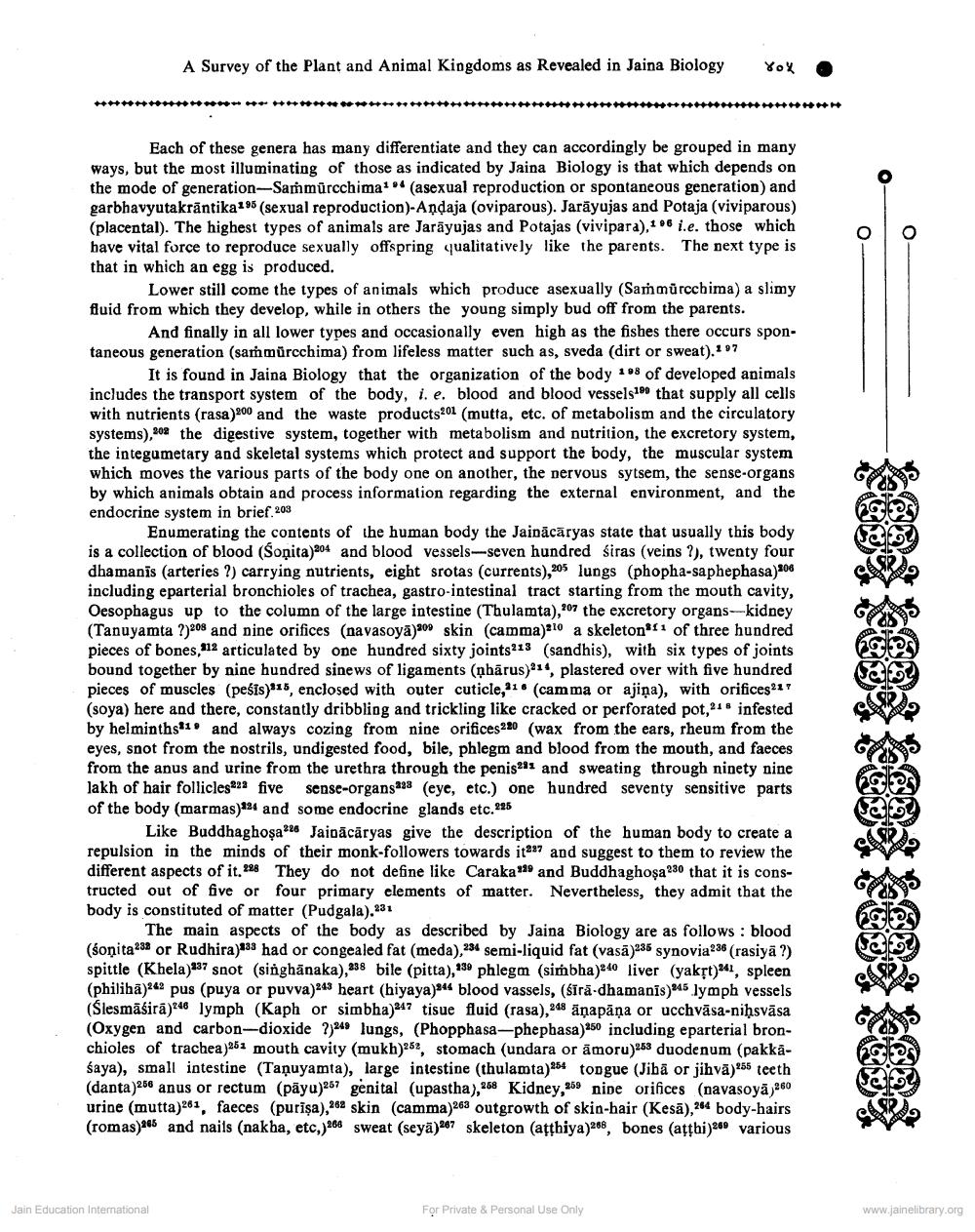________________
A Survey of the Plant and Animal Kingdoms as Revealed in Jaina Biology
४०५
Each of these genera has many differentiate and they can accordingly be grouped in many ways, but the most illuminating of those as indicated by Jaina Biology is that which depends on the mode of generation-Sammürcchima1 (asexual reproduction or spontaneous generation) and garbhavyutakrantika195 (sexual reproduction)-Andaja (oviparous). Jarayujas and Potaja (viviparous) (placental). The highest types of animals are Jarayujas and Potajas (vivipara), 106 i.e. those which have vital force to reproduce sexually offspring qualitatively like the parents. The next type is that in which an egg is produced.
*******
Lower still come the types of animals which produce asexually (Sammurcchima) a slimy fluid from which they develop, while in others the young simply bud off from the parents.
And finally in all lower types and occasionally even high as the fishes there occurs spontaneous generation (sammürcchima) from lifeless matter such as, sveda (dirt or sweat). 197
It is found in Jaina Biology that the organization of the body 18 of developed animals includes the transport system of the body, i. e. blood and blood vessels 100 that supply all cells with nutrients (rasa)200 and the waste products 201 (mutta, etc. of metabolism and the circulatory systems),202 the digestive system, together with metabolism and nutrition, the excretory system, the integumetary and skeletal systems which protect and support the body, the muscular system which moves the various parts of the body one on another, the nervous sytsem, the sense-organs by which animals obtain and process information regarding the external environment, and the endocrine system in brief, 203
Enumerating the contents of the human body the Jainācāryas state that usually this body is a collection of blood (Śonita)204 and blood vessels-seven hundred siras (veins ?), twenty four dhamanīs (arteries ?) carrying nutrients, eight srotas (currents),205 lungs (phopha-saphephasa) 306 including eparterial bronchioles of trachea, gastro-intestinal tract starting from the mouth cavity, Oesophagus up to the column of the large intestine (Thulamta), 207 the excretory organs-kidney (Tanuyamta ?)208 and nine orifices (navasoya)209 skin (camma)210 a skeleton of three hundred pieces of bones,112 articulated by one hundred sixty joints 213 (sandhis), with six types of joints bound together by nine hundred sinews of ligaments (pharus)214, plastered over with five hundred pieces of muscles (peśis)115, enclosed with outer cuticle,31 (camma or ajiņa), with orifices217 (soya) here and there, constantly dribbling and trickling like cracked or perforated pot,21 infested by helminths and always cozing from nine orifices220 (wax from the ears, rheum from the eyes, snot from the nostrils, undigested food, bile, phlegm and blood from the mouth, and faeces from the anus and urine from the urethra through the penis21 and sweating through ninety nine lakh of hair follicles222 five sense-organs (eye, etc.) one hundred seventy sensitive parts of the body (marmas)24 and some endocrine glands etc.225
Jain Education International
Like Buddhaghosa226 Jainācāryas give the description of the human body to create a repulsion in the minds of their monk-followers towards it227 and suggest to them to review the different aspects of it. 228 They do not define like Caraka129 and Buddhaghosa230 that it is constructed out of five or four primary elements of matter. Nevertheless, they admit that the body is constituted of matter (Pudgala),231
The main aspects of the body as described by Jaina Biology are as follows: blood (sonita23 or Rudhira)33 had or congealed fat (meda),234 semi-liquid fat (vasa)235 synovia 236 (rasiya?) spittle (Khela)237 snot (singhanaka),338 bile (pitta), 139 phlegm (simbha)240 liver (yakṛt)41, spleen (philiha)242 pus (puya or puvva) 243 heart (hiyaya)24 blood vassels, (śīrā-dhamanis) 245 lymph vessels (Ślesmāśira)246 lymph (Kaph or simbha)247 tisue fluid (rasa), 248 aṇapāņa or ucchvāsa-niḥsvāsa (Oxygen and carbon-dioxide ?)249 lungs, (Phopphasa-phephasa)250 including eparterial bronchioles of trachea)251 mouth cavity (mukh)252, stomach (undara or amoru)253 duodenum (pakkaśaya), small intestine (Tanuyamta), large intestine (thulamta) 254 tongue (Jiha or jihva) 255 teeth (danta)250 anus or rectum (payu)257 genital (upastha), 258 Kidney, 259 nine orifices (navasoya,260 urine (mutta) 261, faeces (purīşa),282 skin (camma) 263 outgrowth of skin-hair (Kesa), 24 body-hairs (romas)25 and nails (nakha, etc,)266 sweat (seya)267 skeleton (atthiya)266, bones (atthi)269 various
For Private & Personal Use Only
www.jainelibrary.org




